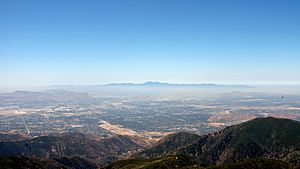San Bernardino Valley facts for kids
The San Bernardino Valley (which in Spanish is called Valle de San Bernardino) is a large valley located in Southern California. It's a busy and important area, home to many cities and people. This valley is part of a bigger region known as the Inland Empire, which is famous for its warm weather and beautiful mountains.
Contents
What is the San Bernardino Valley?
The San Bernardino Valley is a wide, flat area of land surrounded by mountains. To the north, you'll see the tall San Bernardino Mountains. To the west are the San Gabriel Mountains. These mountains help shape the valley and create its unique climate. The valley is a key part of San Bernardino County, one of the largest counties in the United States.
Where is the San Bernardino Valley Located?
This valley sits in the heart of Southern California. It's about 60 miles (97 kilometers) east of Los Angeles. Many major highways, like Interstate 10 and Interstate 215, run through the valley. This makes it a central spot for travel and trade in the region.
Cities in the Valley
Many cities call the San Bernardino Valley home. Some of the biggest include:
- San Bernardino
- Riverside (though often considered part of the broader Inland Empire, its western edge touches the valley)
- Fontana
- Rialto
- Redlands
- Colton
- Ontario
These cities have grown a lot over the years. They offer many opportunities for jobs, education, and fun activities.
History of the San Bernardino Valley
The San Bernardino Valley has a rich history, going back thousands of years. Native American tribes lived here long before anyone else. Later, Spanish explorers and missionaries arrived, followed by American settlers.
Early Inhabitants
For thousands of years, the Tongva and Serrano Native American tribes lived in the valley. They used the natural resources, like the rivers and plants, to survive. They had a deep connection to the land and its environment.
Spanish Exploration and Missions
In the late 1700s, Spanish explorers came to California. They named the valley "San Bernardino" after Saint Bernardine of Siena. In 1810, a Spanish mission outpost was built here. This outpost helped spread Spanish culture and farming methods.
American Settlement and Growth
After California became part of the United States in the mid-1800s, more people moved to the valley. The Mormons were among the first American settlers. They helped build the city of San Bernardino. The arrival of railroads in the late 1800s brought even more growth. Farmers grew citrus fruits, like oranges, which became a big part of the valley's economy.
Geography and Climate
The San Bernardino Valley has a unique geography and climate. It's known for its warm, dry summers and mild, wet winters. The surrounding mountains play a big role in shaping the weather.
Mountains and Passes
The valley is bordered by several mountain ranges:
- The San Bernardino Mountains to the north and east. These mountains are home to popular ski resorts and forests.
- The San Gabriel Mountains to the west. These mountains are rugged and beautiful.
- The Cajon Pass is a famous mountain pass located northwest of the valley. It's a major route for trains and cars traveling between Southern California and other states.
Rivers and Water Sources
The Santa Ana River is the main river flowing through the valley. It's an important source of water for the region. The valley also relies on underground water sources, called aquifers, and water brought in from other parts of California.
What is the Weather Like?
The San Bernardino Valley has a Mediterranean climate. This means:
- Summers are hot and dry, with temperatures often reaching over 90°F (32°C).
- Winters are mild and wet, with occasional rain. Snow is rare in the valley itself, but it falls often in the nearby mountains.
- Sometimes, strong winds called Santa Ana winds blow through the valley. These winds are hot and dry and can increase the risk of wildfires.
Economy and Transportation
The San Bernardino Valley is an important center for trade, transportation, and industry. Its location makes it a key hub for moving goods across the country.
Transportation Hub
The valley is a major transportation center. It has:
- Highways: Several major interstate highways, including I-10, I-15, and I-215, cross through the valley.
- Railroads: Major railway lines connect the valley to ports and other cities.
- Airports: The San Bernardino International Airport (SBD) is growing and handles cargo and some passenger flights. The Ontario International Airport (ONT) is also nearby and serves millions of passengers each year.
Major Industries
The economy of the San Bernardino Valley has changed over time.
- Logistics and Warehousing: Because of its central location and good transportation, the valley is a huge center for storing and moving goods. Many large warehouses and distribution centers are located here.
- Education: Several colleges and universities are in the valley, including California State University, San Bernardino and the University of Redlands.
- Healthcare: Hospitals and medical centers are major employers in the region.
- Manufacturing: Some manufacturing companies still operate in the valley.
Images for kids
-
Occasional January snowfall in the eastern San Bernardino Valley. The Shandin Hills are visible in the background.
-
Junction of the San Gabriel and San Bernardino Mountains. The I-210 (Foothill Freeway) runs parallel, I-215 intersects leading to the Cajon Pass.





